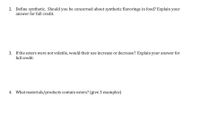
Chemistry
10th Edition
ISBN: 9781305957404
Author: Steven S. Zumdahl, Susan A. Zumdahl, Donald J. DeCoste
Publisher: Cengage Learning
expand_more
expand_more
format_list_bulleted
Concept explainers
Question

Transcribed Image Text:2. Define synthetic. Should you be concerned about synthetic flavorings in food? Explain your
answer for full credit.
3. If the esters were not volatile, would their use increase or decrease? Explain your answer for
full credit.
4. What materials/products contain esters? (give 3 examples)
Expert Solution
This question has been solved!
Explore an expertly crafted, step-by-step solution for a thorough understanding of key concepts.
This is a popular solution
Trending nowThis is a popular solution!
Step by stepSolved in 3 steps

Knowledge Booster
Learn more about
Need a deep-dive on the concept behind this application? Look no further. Learn more about this topic, chemistry and related others by exploring similar questions and additional content below.Similar questions
- 2. a. Draw the structure of DDT and its metabolite DDE, and state what the initials stand for. b. Explain why DDT is an insecticide and DDE is not. c. What is effect of DDE on the ecosystem?arrow_forward• Which is your favorite fruit? Apple or Orange? • Refer to Carboxylic Esters in your reading, to express your opinions on the connection between fruity odor and organic esters. Objectives ● Explain the naming of esters and describe their synthesis and hydrolysis. • Describe the physical properties of esters. Instructions ● In your initial response, 1. Illustrate the functional group of an ester and show how an ester can be synthesized. 2. Give the name of one ester which has a fruity flavor. The following like may help you to find your fruit Fatarrow_forwardWrite TRUE if the statement is correct, FALSE if otherwise. 11. Both fats and oils are mixtures of esters containing both saturated and unsaturated compounds. 12. Fats and oils are esters made from glycerol and long chain carboxylic acids. 13. Potassium iodide is used as a solubilizing agent. 14. The greater the iodine number, the greater the number of double bonds. 15.Butter, beef fat and lard have high iodine numbers.arrow_forward
- User Guard™ What kind of functional group is hydrolyzed to form soap? A. Aldehyde B. Amine C. Acid chloride D. Ester Q Search ****** ******* ********* *** app.honorlock.com 99+arrow_forwardThe following fatty acid is ______ and would more likely be a(n) ______ at room temperature.arrow_forward2. Consider the following pairs of compounds. For each pair, predict which compound has greater solubility in water and explain why. Refer to the compound's ability to from hydrogen bonds. You may wish to review pages 111-112 in your textbook. A. hexane and hexanol Answerarrow_forward
- Macmillan Learning Read the thermometer and report the temperature with the proper number of digits. temperature = 32.1 Incorrect °℃ 100 80 70 60 50 40 30 20 10 90arrow_forward4. Assume that an esterification reaction is done using 0.10 moles of a carboxylic acid and 1.0 moles of an alcohol. What is the theoretical yield (in moles) for the reaction? (You can write a generic esterification reaction to help answer this question and recognize the limiting reagent.) 5. A student completes the reaction described in question 4 and obtains 5.3 g of the product (the product has a molecular mass of 74.0 g/mol). a) What is the actual yield (the moles of product obtained)? Show your calculation, including units. 5.3 g product X mol products b) Calculate the % yield for the reaction. Show your calculation, including units.arrow_forward
arrow_back_ios
arrow_forward_ios
Recommended textbooks for you
 ChemistryChemistryISBN:9781305957404Author:Steven S. Zumdahl, Susan A. Zumdahl, Donald J. DeCostePublisher:Cengage Learning
ChemistryChemistryISBN:9781305957404Author:Steven S. Zumdahl, Susan A. Zumdahl, Donald J. DeCostePublisher:Cengage Learning ChemistryChemistryISBN:9781259911156Author:Raymond Chang Dr., Jason Overby ProfessorPublisher:McGraw-Hill Education
ChemistryChemistryISBN:9781259911156Author:Raymond Chang Dr., Jason Overby ProfessorPublisher:McGraw-Hill Education Principles of Instrumental AnalysisChemistryISBN:9781305577213Author:Douglas A. Skoog, F. James Holler, Stanley R. CrouchPublisher:Cengage Learning
Principles of Instrumental AnalysisChemistryISBN:9781305577213Author:Douglas A. Skoog, F. James Holler, Stanley R. CrouchPublisher:Cengage Learning Organic ChemistryChemistryISBN:9780078021558Author:Janice Gorzynski Smith Dr.Publisher:McGraw-Hill Education
Organic ChemistryChemistryISBN:9780078021558Author:Janice Gorzynski Smith Dr.Publisher:McGraw-Hill Education Chemistry: Principles and ReactionsChemistryISBN:9781305079373Author:William L. Masterton, Cecile N. HurleyPublisher:Cengage Learning
Chemistry: Principles and ReactionsChemistryISBN:9781305079373Author:William L. Masterton, Cecile N. HurleyPublisher:Cengage Learning Elementary Principles of Chemical Processes, Bind...ChemistryISBN:9781118431221Author:Richard M. Felder, Ronald W. Rousseau, Lisa G. BullardPublisher:WILEY
Elementary Principles of Chemical Processes, Bind...ChemistryISBN:9781118431221Author:Richard M. Felder, Ronald W. Rousseau, Lisa G. BullardPublisher:WILEY

Chemistry
Chemistry
ISBN:9781305957404
Author:Steven S. Zumdahl, Susan A. Zumdahl, Donald J. DeCoste
Publisher:Cengage Learning

Chemistry
Chemistry
ISBN:9781259911156
Author:Raymond Chang Dr., Jason Overby Professor
Publisher:McGraw-Hill Education

Principles of Instrumental Analysis
Chemistry
ISBN:9781305577213
Author:Douglas A. Skoog, F. James Holler, Stanley R. Crouch
Publisher:Cengage Learning

Organic Chemistry
Chemistry
ISBN:9780078021558
Author:Janice Gorzynski Smith Dr.
Publisher:McGraw-Hill Education

Chemistry: Principles and Reactions
Chemistry
ISBN:9781305079373
Author:William L. Masterton, Cecile N. Hurley
Publisher:Cengage Learning

Elementary Principles of Chemical Processes, Bind...
Chemistry
ISBN:9781118431221
Author:Richard M. Felder, Ronald W. Rousseau, Lisa G. Bullard
Publisher:WILEY